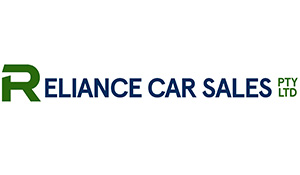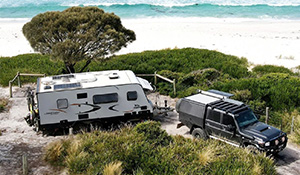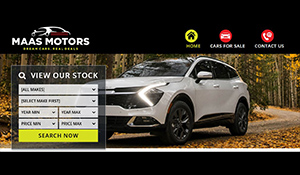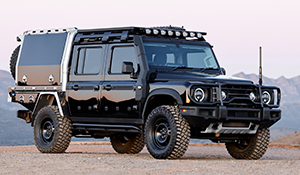Top 5: Towing Wagons
Claimed braked towing capacities have been increasing steadily over the past few years and these days many large 4x4 wagons can legally haul more than 3000kg, and some up to 3500kg. But while many vehicles are rated to haul 3500kg, they can’t do it with equal ease, and there are often caveats to be aware of, like, when towing at the maximum rating, your vehicle’s luggage and people carrying capacity will be reduced to virtually nothing.
So, what makes one vehicle more suited to towing a heavy trailer than another? Well there are, in fact, several factors including engine output, gearbox type, overall gearing, vehicle dimensions, chassis design, suspension type, fuel economy and sophistication of electronic traction aids.
While there are many utes on the market rated to haul a 3500kg trailer, for this article we’re focusing on the Top 5 Towing Wagons. After all, not everyone wants to compromise on day-to-day comfort and practicality that owning a ute can entail, and others will simply require the seven- or eight-seat capacity that only a wagon can provide.

Doing the math. Let’s use the Ford Ranger as an example, and that’s because it and other dual-cab utes are embroiled in the 3500kg towing capacity ‘power’ battle. The math work for all towing vehicles. The Ford Ranger offers a 6000kg GCM, and let’s say we want to tow 3500kg. That means 6000 – 3500 = 2500kg, the maximum the Ranger can weigh if it is to tow 3500kg.
The Ranger’s tare weight is 2200kg, so 2500-2200 = 300kg of payload. Which is not very much at all, if we put four people in the truck they’d need to be 75kg each as 75kg multiplied by four = 300kg. Now you see what we mean when we say that the 3500kg tow ratings aren’t always realistic. And it’s very likely the kerb weight listed by manufacturers doesn’t include a tow bar.
If we go the other way for the Ranger, looking at how much we can tow when at GVM then it’s this: GCM of 6000kg – GVM of 3200kg = tow capacity of 2800kg, the most a trailer’s ATM can be.
Bottom line is if you work off the GCM then you can only tow 3500kg in a Ranger if you have no more than 300kg of load on the truck, or if the truck is at GVM, you can tow 2800kg.

Power and Torque. If you’re going to tow a trailer that weighs more than 2500kg, let alone near 3500kg, you’re going to need a vehicle with decent power and, more importantly, a lot of torque. While peak power is all well and good when you want to go fast, when you want to haul a heavy load it’s torque that makes all the difference, and the lower the torque is developed in the engine’s rev range the better.
Peak power is developed at high revs and is handy for overtaking on the open road, but when you want to get going from standstill, or climb long hills without revving the engine too hard, it’s torque that does the job. Many vehicles that are well suited to towing will have a peak torque output that’s spread across the lower part of the rev range.
For example, while the Toyota LandCruiser 200 Series TDV8 develops its peak power of 200kW at 3600rpm, it makes its peak torque of 650Nm from a low 1600rpm through to 2600rpm. This means the engine develops plenty of pulling power across a wide rev range, which is ideal for pulling a trailer.
Most turbo-diesel engines will develop more torque at lower revs and across a wider rev range than their petrol counterparts, which is one of the reasons they’re so well suited to towing duties. For example, while the LandCruiser’s 4.5L turbo-diesel V8 makes 650Nm from 1600-2600rpm, the Nissan Patrol’s larger capacity 5.6-litre petrol V8 makes a 560Nm of peak torque at a much higher 4000rpm. Sure, the Patrol also makes a whopping 298kW of power at 5000rpm, but the only time you’ll use that when towing a heavy trailer is if you’re tying to pass a road train.

Gearbox. There’s little doubt that modern automatic transmissions are better suited to towing duties than manual gearboxes. While most manual gearboxes offer five or six forward ratios, many modern autos have between six and nine ratios. And the more forward gears available the easier it is to keep engine revs at or near peak torque output. Autos also offer have a torque multiplying effect, which benefits acceleration from standstill, yet they have lock-up torque converters to minimise fuel consumption.
Another advantage of autos is shift speed. Modern autos usually shift through ratios so quickly that gear changes are almost imperceptible, so there’s no disconnection of drive and therefore no loss of momentum when upshifting. With a manual gearbox, each time you put your foot on the clutch pedal to change gears you lose drive, which interrupts forward momentum.
Towing heavy trailers with a manual vehicle can also result in premature clutch wear and additional strain on driveline components… unless gearshifts are consistently smooth.

Vehicle dimensions. Vehicles with a long wheelbase and a wide track offer a more stable towing platform than short-wheelbase vehicles with a narrow track.
A long-wheelbase vehicle will not tend to pitch fore and aft as much as a shorty, especially when the weight of a trailer is placed on the tow hitch. This makes it easier to keep the vehicle and trailer combination travelling along smoothly, especially when accelerating and braking, as well as driving over bumpy and undulating surfaces.
Likewise, the wider the vehicle track the less tendency for body roll when cornering, which will provide a more stable and secure feeling when towing. Vehicles with a short distance between the rear axle and the tow hitch will also offer greater stability than vehicles with a long rear overhang.

Vehicle design. Traditional 4x4 wagons feature a strong separate chassis with the body bolted on top, and this design has long been accepted as best suited to heavy towing duties. But many modern 4x4 wagons, such as the Jeep Grand Cherokee, Land Rover Discovery and Volkswagen Touareg have super-strong monocoque structures that are as equally suited to hauling three-tonne and heavier trailers.
The rear suspension design of a vehicle can also have a bearing on its suitability as a towing wagon. A vehicle with a live-axle at the rear will always keep its rear wheels perpendicular to the road surface regardless of tow ball load, whereas a heavy load on a vehicle with independent suspension can cause negative camber, which in turn can result in premature tyre wear at the inside edge of the tread surface.
It should be noted, however, that some vehicles with self-levelling systems and height adjustable air suspension, such as the Jeep Grand Cherokee and Land Rover Discovery, can compensate for the extra load of a trailer to prevent the occurrence of negative camber.
Electronic traction aids. One of the greatest advancements in vehicle design when it comes to towing safety has been in the area of electronic traction aids, such as anti-lock brakes, traction control, stability control, electronic brake-force distribution, emergency brake assist, roll-over mitigation and, of most relevance here, trailer sway control.
If you’re on the market for a towing vehicle, especially if you have a trailer approaching a vehicle’s maximum towing capacity, look for a model with all of the electronic traction aids you can find.

Other considerations. As well as their relatively high low-rpm torque outputs, modern turbo-diesel engines will deliver much better fuel economy than their petrol-engine counterparts, especially when working hard such as when towing heavy trailers. And while the cost of fuel might not be an issue for everyone, the increased touring range of an economical towing vehicle probably will be.
Other vehicle features that make life easier when towing include a reversing camera with dynamic guidance lines and front and rear parking sensors. Other cameras that offer vision around the vehicle’s perimeters can also help when manoeuvring in tight spots.

Here’s a list of the Top 5 Towing Wagons on the market today. They have been listed in alphabetical order rather than a ranking, as they range in price from just over $50k to well over $100k, so are not directly comparible.
Ford Everest. The Ford Everest is the best of the ute-based wagons when it comes to towing thanks to its strong 3.2-litre turbo-diesel engine, live-axle rear end and standard Trailer Sway Control. It has a class competitive 3000kg maximum braked towing capacity and a 300kg tow ball weight.
Price: $52,990-$74,701+ORC Maximum Towing Capacity: 3000kg Maximum Tow Ball Load: 300kg Engine: 3.2L TD5 Power: 143kW at 3000rpm Torque: 470Nm at 1750-2500rpm Transmission: Six-speed auto 4WD type: Full-time Wheelbase: 2850mm Track (front/rear): 1560/1564mm Chassis: Separate body on chassis Suspension (front/rear): Independent, coil-over struts/live-axle, coil springs Electronic towing aids: Trailer Sway Control

Jeep Grand Cherokee Trailhawk. The Trailhawk is the cheapest way to get into a Jeep Grand Cherokee with air suspension and despite its relatively compact dimensions this five-seat 4x4 wagon has a generous wheelbase, wide track, strong engine and many other features that make it a top towing rig.
Price: $73,500+ORC Maximum Towing Capacity: 3500kg Maximum Tow Ball Load: 350kg Engine: 3.0L TDV6 Power: 184kW at 4000rpm Torque: 570Nm at 2000rpm Transmission: Eight-speed auto 4WD type: Full-time Wheelbase: 2915mm Track (front/rear): 1628/1634mm Chassis: Monocoque Suspension (front/rear): Independent, air springs/independent, air springs (height adjustable) Electronic towing aids: Trailer Sway Control

Land Rover Discovery TD6. The Land Rover Discovery TD6 has a powerful yet economical turbo-diesel engine, an eight-speed auto, a wide track, a long wheelbase and a full suite of electronic traction aids.
Price: $78,750-$116,800+ORC Maximum Towing Capacity: 3500kg Maximum Tow Ball Load: 350kg Engine: 3.0L TDV6 Power: 190kW at 3750rpm Torque: 600Nm at 1750-2250rpm to Transmission: Eight-speed auto 4WD type: Full-time Wheelbase: 2923mm Track (front/rear): 1692/1687mm Chassis: Monocoque Suspension (front/rear): Independent, air springs/independent, air springs (height adjustable) Electronic towing aids: Trailer Stability Assist

Toyota LandCruiser 200 TDV8. The Toyota LandCruiser 200 Series has all of the attributes needed in a heavy-duty towing vehicle, including a strong turbo-diesel V8 engine, tough separate chassis, live-axle rear suspension and standard Trailer Sway Control across the entire range.
Price: $78,261-$120,30+ORC Maximum Braked Towing Capacity: 3500kg Maximum Tow Ball Load: 350kg Engine: 4.5L TDV8 Power: 200kW at 3600rpm Torque: 650Nm at 1600-2600rpm Transmission: Six-speed auto 4WD type: Full-time Wheelbase: 2850mm Track (front/rear): 1640/1635mm Chassis: Separate body on chassis Suspension (front/rear): Independent, coil-over struts/live-axle, coil springs Electronic towing aids: Trailer Sway Control

Volkswagen Touareg V8 TDI R-Line. Price: $116,300+ORC Maximum Towing Capacity: 3500kg Maximum Tow Ball Load: 280kg Engine: 4.2L TDV8 Power: 250kW at 4000rpm Torque: 800Nm at 1750-2750rpm Transmission: Eight-speed auto 4WD type: Full-time Wheelbase: 2904mm Track (front/rear): 1638/1658mm Chassis: Monocoque Suspension (front/rear): Independent, air springs/ independent, air springs (height adjustable) Electronic towing aids: Electronic Stabilisation Program
Words Dean Mellor










